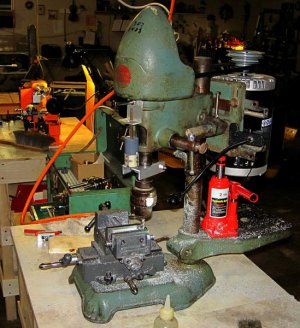Been following all week without comment. Seems the thread digressed a couple of times without any real answer. Beats me too, unless there is a third pulley involved.
The outer diameter of each sheave is close enough for a ball park speed figure. Adjusting belt size will make a small difference but not the sort you would call a radical change. Generating the symbol for "pi" on a laptop is a pita, I just spell it out. Fewer keystrokes, that I can't remember anyway.
One thing that bothers me is the motor specs. An AC motor runs based on frequency. A 2 pole motor synchronous field is at 3600 RPM. A 4 pole motor field is at 1800. This for the States at 60 Hz. 50 Hz motors are a fuzz slower. But if run on 60 Hz, will run at 3600/1800 RPM. There is a formula for figuring that but throws in more complication. [F=PS/120] F of course is frequency, 60 here, 50 overseas. P is poles, and S is speed. The 120 is a constant. This is the rotating field, and works for both single phase and three phase motors. Basic algebra shifting things around yields the desired variable.
Slip, a technical term, is the actual speed of the shaft. It will show
unloaded as ~3450/~1740, and is where the motor gets its' power. The ~3000 speed you described doesn't fit unless the motor is a 50 Hz at the name plate. But even then, if the motor runs at 60 Hz, which will be 3450/1740 RPM at the shaft.
I have a "recent" Craftsman DP.(within the last 20 odd years) There is a third sheave that allows for relatively low running speed. Call it two belts, in series. That's the only answer I can see that fits the wide difference between the calculated speed VS the measured speed you described.
That, or a gear reduction, which I don't see on a drill press, unless home brew. I had one I fitted a few years ago, gone now. Look at my site,
http://www.hudsontelcom.com/9X20Gear.html for a description of the mechanism. The gizmo is roughly 3:1. Running backward would yield what you describe. But unlikely. There is no other answer unless you
mis-measured the pulleys. That can happen, but you would have to be dumb as a box of rocks. And I don't see that happening, not to a machinist. Sorry for the "negative" comment, it's the only thing that fit here.
You have my sympathies dealing with the insurance company. I imagine with all you had to deal with, they took a solid punch in the solar plexus and look for the slightest excuse not to pay off. Nothing to do but start over. Losing all the old stuff hurts bad. I have books dating back to the 19th century. First editions... I worry about the same thing, constantly. Many cannot be replaced, at
any cost.
Best of luck, Sir. and sorry I don't have a better answer.
Bill Hudson



